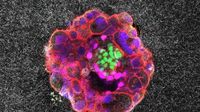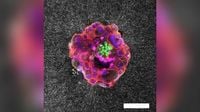For the first time in scientific history, researchers have captured a real-time video of a human embryo implanting itself into a simulated uterine wall — a breakthrough that could redefine our understanding of fertility and early pregnancy. This pioneering achievement, announced on August 15, 2025, comes from a collaborative team at the Institute for Bioengineering of Catalonia in Spain, with support from Dexeus University Hospital in Barcelona. Their findings, published in Science Advances, reveal never-before-seen details of how human embryos embark on their journey to life, potentially opening new avenues for treating infertility and reducing miscarriages.
The process of embryo implantation has long been shrouded in mystery. While scientists have studied animal models and observed the aftermath of implantation via ultrasound, the crucial moments when a human embryo attaches to the uterine lining — the endometrium — have remained out of reach. As Samuel Ojosnegros, head of bioengineering in reproductive health at the Institute for Bioengineering of Catalonia, put it, “Being able to record a movie of something that has never been seen before, which are the early steps of life — human life — was mind-blowing.”
To overcome the challenge of observing this fleeting and delicate process, the Spanish research team engineered an artificial womb. They created a collagen-based matrix, closely mimicking the natural uterine environment. Into this matrix, they placed early-stage human embryos — five days old and donated by couples who had undergone infertility treatments. The embryos were left to settle overnight, while the scientists employed advanced time-lapse microscopy and fluorescence imaging to capture the action in vivid 3D and full color.
The resulting footage was nothing short of astonishing. For the first time, scientists could watch as a human embryo burrowed into the artificial uterine wall, exerting considerable force and using enzymes to break down the surrounding tissue. Ojosnegros described the process as “a surprisingly invasive process.” He elaborated, “We can see how the embryo penetrates this matrix and sort of digs a hole in the matrix.” The embryo’s movements, likened by graduate student Amelie Godeau to “little fingers or little arms,” allowed it to pull itself deeper into the matrix, demonstrating a level of activity and force that surprised even seasoned researchers.
What set human embryos apart from their mouse counterparts, as the study revealed, was their sheer vigor. Unlike mouse embryos, which appeared to be passively enveloped by the womb, human embryos actively reshaped their environment, pulling and reorganizing fibers as they dug in. “Everything was different, the size, the shape, the behavior. They were stronger, more forceful, digging a hole into the matrix in a remarkably invasive way. Every detail felt unique,” Ojosnegros recounted to UPI. This forceful behavior may also provide a scientific explanation for “implantation cramps” — the twinges and sensations many women report during early pregnancy. As Godeau noted, “Many women report this kind of itching or so at the moment where an embryo could be implanting. It can explain these implantation cramps that women are feeling when the embryo implants.”
The implications of this discovery are profound. According to the researchers, implantation failure is a leading cause of infertility, accounting for about 60% of miscarriages. “Implantation is the main roadblock of human infertility, by far. It’s the main cause,” Ojosnegros emphasized. In the context of assisted reproductive technologies like in vitro fertilization (IVF), the statistics are equally sobering: only 25% to 30% of transferred embryos — whether conceived naturally or in the lab — successfully implant. Embryo quality is a significant factor, but until now, doctors could only observe embryos at the time of transfer and then weeks later via ultrasound, leaving a critical gap in understanding.
The new system developed by the Catalonia team offers a window into this hidden stage of development. Their ex vivo model — meaning outside the body — allows scientists to test different culture conditions and compounds that might improve implantation rates. In fact, the team has already developed a protein supplement, now available through their spin-off company Serabiotics in partnership with the Spanish pharmaceutical firm Grifols, designed to enhance implantation in clinical settings.
The researchers also observed that the embryo’s interaction with the artificial matrix was influenced by external forces, such as the addition of other cells or structures. This led them to hypothesize that uterine contractions — which occur one to two times per minute in the human body and vary throughout the menstrual cycle — may play a crucial role in successful implantation. “We hypothesize that contractions occurring in vivo may influence embryo implantation,” Godeau explained. Previous studies have suggested that an optimal frequency of these contractions is linked to higher implantation rates, though the exact mechanisms remain a subject for further research.
Experts worldwide have hailed the study as a major leap forward. Amy Sparks, director of in vitro fertilization and reproductive testing laboratories at the University of Iowa, called it “an amazing body of work” and “a big deal.” Magdalena Zernicka-Goetz, a leading authority on human developmental biology at the California Institute of Technology, agreed: “It really takes a major step towards opening one of the black boxes of human development. It’s beautiful.”
Still, there are important caveats. As Dr. Mark Trolice, professor at the University of Central Florida College of Medicine, pointed out to UPI, “Before any treatment can be used, scientists will need to do human clinical trials. There are also important ethical and legal rules about using human tissues and embryos, which researchers must follow.” The research, while groundbreaking, was conducted in a laboratory environment using donated embryos and artificial matrices, which, while closely mimicking the uterus, are not a perfect substitute for the real thing.
Nevertheless, the new ability to observe and measure the forces at play during implantation offers fresh hope to the millions of individuals and couples struggling with infertility. By illuminating the earliest steps of human life, this research not only answers long-standing questions but also lays the foundation for more effective fertility treatments and a deeper appreciation of the complexity and resilience of early human development.
With every frame of the newly captured video, scientists are now closer than ever to understanding — and perhaps one day improving — the very first moments that make life possible.

